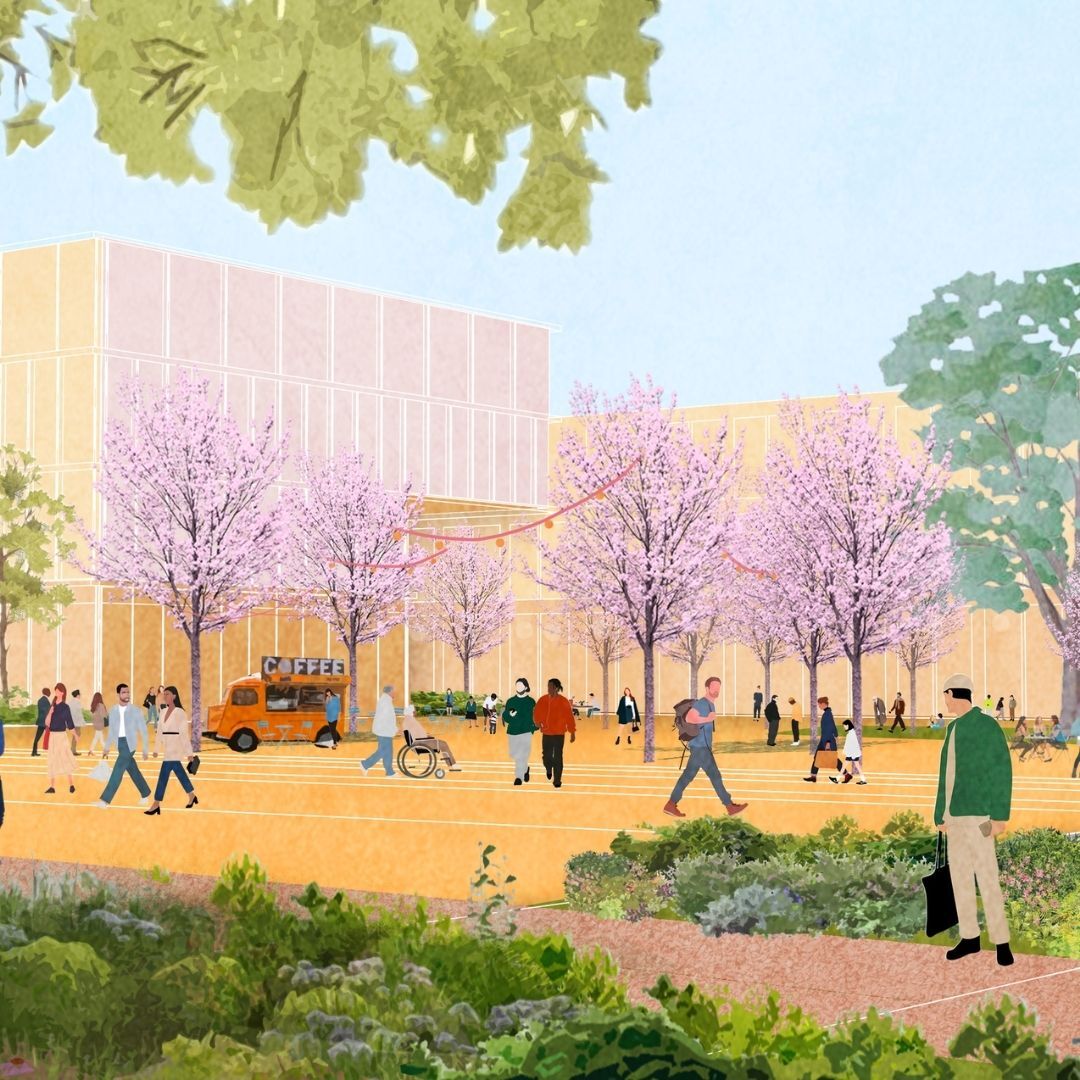Project showcase
Golden Valley, Cheltenham, for Cheltenham Borough Council and Henry Boot Developments, with Grimshaw, Grant Associates, HGH Consulting, Buro Happold, Vectos and EDP

At 27.6ha, Golden Valley is cyber security specialty innovation district in west Cheltenham located near GCHQ. Valued at £1bn, the Golden Valley hosts over 550 homes, 1 million sq ft of workspace, and 11.75ha public green and open space with 35% of housing designated affordable. Enhanced public transport, public spaces, leisure facilities, cycle and walking routes stitch together new and existing communities.
Who is on the project team? (designer, consultants, etc)
Grimshaw – Master planner/ lead consultant
Grant Associates – Landscape Architect
hgh Consulting – Planning
Vectos/ SLR Consulting – Transport
Buro Happold – Civils, utilities, hydrology, EIA, waste and sustainability
EDP - Ecology
Describe the context of this project, its neighbourhood and people.
Golden Valley is designed to support the development of the UK’s largest cyber security specialty innovation district in west Cheltenham. This pioneering garden community, set within a rich, biodiverse landscape reinforced by green infrastructure, will provide over 1 million square feet of workspace and over 550 high-quality new homes served by people-first streets, smart mobility and intelligent services. The masterplan forms the centrepiece of the west Cheltenham strategic allocation site known as The Golden Valley Development (GVD), and is the largest employment area within the wider development. The GVD is a greenfield site of land parcels held in multiple ownerships, in collaboration with which will provide a rich holistic new edge to Cheltenham. Government Communication Headquarters (GCHQ) is located 250m from the site of the masterplan, offering opportunities for expansion and collaboration. GCHQ is one of several hubs in the Bristol-Birmingham ‘Cyber Arc’, which represents one of the fastest growing sectors of the UK economy. Contrasted with this are several communities in the neighbourhoods that abut the GVD, which are among the most deprived in Cheltenham. In addition to providing new opportunities and growth in the cyber industry, the site of the Golden Valley masterplan, which is owned by Cheltenham Borough Council, has been developed through regular dialogue with the local planning authority to provide multi-sector jobs, affordable homes, basic healthcare, enhanced public transport, and a wealth of public spaces, leisure facilities, cycle and walking routes for health and wellbeing to stitch together new and existing communities.
Please describe your approach to this future place and its mix of uses. How will it function as a vibrant place? How does it knit into, and serve the needs of, the wider area?
The design approach for Golden Valley is founded on the natural physical systems of the site, with the existing waterways, landscape habitats, ecology, biodiversity, and soil left in better shape than when they were found, and the community incentivised to continue to grow sustainably. The masterplan sets this ambition with: o A NATURE NARRATIVE Preservation of a primordial and distinct natural environment forms an essential part of the masterplan – recovering stories of the past through native species, habitats, and ecology. Historic landscapes in the UK have been degraded by years of intensive agricultural practice. A new narrative of nature is designed to encourage essential improvements of the landscape and community: regenerating the soil, cleaning the air, enabling pollination, and improving the quality of ground water. o A VIABLE COMMUNITY As a knowledge, research and innovation district, the progressive national and globally connected economy of Golden Valley will be a place that supports a diverse existing and future community. Exemplary homes, leisure facilities, and services will revitalise west Cheltenham and its environs, with public spaces stimulating community interaction and collaboration. o A SMART FUTURE Harnessing the benefits of a digital infrastructure, Golden Valley will be a place that through data-informed knowledge will create physical environments that are optimised for sustainable living: a smart, green community. This technology will inform the community – monitoring energy and water consumption, identifying opportunities to reduce carbon footprints, and encouraging the use of and care for natural habitats.
What is the environmental impact of the project? How will the carbon use and material impact of the development be mitigated? What is the sustainability strategy?
TRANSPORT: The Golden Valley masterplan prioritises walkable, cyclable neighbourhoods, reducing dependence on the private car. Enhanced public transport services planned in conjunction with improvements to walking and cycling infrastructure will facilitate non-car access to Cheltenham and Gloucester, including the town centres and railway stations for onward travel, considerably reducing carbon emissions. There has been focus using materials with a lower carbon footprint in grey infrastructure elements – roads, surface parking areas, kerbs, which will make up a large part of the baseline embodied carbon.
ENERGY: The energy strategy focuses on passive measures, efficiencies, and low energy demand, as well as low and zero carbon technologies including maximising PV cover on all roofs and using lower whole life carbon footprint materials in homes. An all-electric approach is proposed to achieve net-zero carbon emissions from operational energy use, and building materials will be carefully chosen to reduce embodied carbon impacts. A district-wide system for heat storage facilitates efficient heating and cooling, and ensures minimal wastage. GREEN INFRASTRUCTURE: Over 45% of the total site area is composed of green space and sustainable urban drainage systems with a mosaic of habitats supporting biodiversity. Planting and species selection strategies maximise carbon sequestration with blue and green roofs, contributing to CO2 reduction. Carbon impacts will be further reduced through nature-based water harvesting and efficient management.
DIGITAL INFRASTRUCTURE: Technology will monitor energy and water consumption and identify opportunities for the living and working communities to reduce carbon footprints.
Festival of Pineapples
24-26 February 2026
Pineapples prize giving night
April
Pineapples at Festival of Place
10 June 2026
© The Pineapples - Tweak Ltd. 124 City Road, London, EC1V 2NX. Tel: 020 3326 7238




